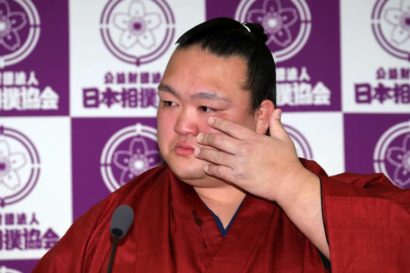
Kisenosato annonce son intai
Le grand champion Kisenosato a confirmé mercredi sa décision de se retirer du sumo, faisant cette annonce au lendemain de sa troisième défaite au tournoi de janvier.
Le lutteur de 32 ans était menacé, il a donc décidé de mettre un terme à sa carrière après avoir enregistré un score de 0-3 lors des trois premiers jours du championnat.
« Moi, Kisenosato, je prendrai ma retraite à partir de ce basho et je formerai des lutteurs juniors en tant que toshiyori (aîné dans le sumo) sous le nom d’Araiso. Merci de votre soutien pendant que j’étais actif », a-t-il déclaré.
« Même s’il est très regrettable que je ne sois pas à la hauteur des attentes de tout le monde en tant que yokozuna, je ne regrette rien de ma carrière sur le dohyo« , a-t-il ajouté.
Interrogé sur le traitement de ses blessures, Kisenosato a déclaré qu’il avait souvent réfléchi à la question de savoir si l’heure était venue pour une sortie harmonieuse, mais qu’il ne cessait pas de vouloir combler ses fans pour leur soutien.
« Je suis vraiment désolé que cela se soit passé ainsi« , a-t-il déclaré.
Mercredi matin, son maître de l’écurie Tagonoura, a déclaré aux médias que Kisenosato avait décidé de se retirer après une discussion entre eux la nuit précédente.
« Kisenosato et moi avons parlé pendant 30 à 40 minutes la nuit dernière et il a dit: » S’il vous plaît, laissez-moi prendre ma retraite, je prends ma retraite. » Extérieurement, il avait l’air serein comme il l’est fait toujours, même si je suis sûr que beaucoup de choses lui traversaient l’esprit « , a déclaré Tagonoura. « Ses deux années (en tant que yokozuna) sont passées comme un éclair. Je l’ai remercié pour son travail ardu au fil des ans, je ne pouvais trouver aucun autre mot. »
Bien qu’ayant déclaré être « proche de sa forme idéale » avant le tournoi, Kisenosato s’est incliné face au komusubi Mitakeumi puis contre les maegashira 1 Ichinojo et Tochiozan.
La retraite de Kisenosato, grand favori des fans, laisse deux lutteurs au sommet du banzuke – les Mongols Hakuho et Kakuryu.
Sans compter son forfait le 5e jour de la compétition de Kyushu en novembre, Kisenosato a enregistré huit défaites consécutives depuis septembre, la pire performance pour un yokozuna depuis le format des tournoi sur 15 jours commencé 1949.
En mars 2017, Kisenosato est devenu le premier japonais en 19 ans à obtenir une promotion au rang de yokozuna. Il a remporté deux titres consécutifs.
Ses blessures au genou, à la cheville, à la poitrine et au bras l’ont contraint à se retirer de huit tournois consécutifs entre mai 2017 et juillet 2018 ayant battu un record d’absentéisme pour un yokozuna. De nombreuses questions se sont soulevées sur sa capacité à poursuivre sa carrière en tant que champion.
Le lutteur de l’écurie Tagonoura a terminé sur un score de 10-5 lors de son retour en septembre afin de contrer temporairement les appels à sa retraite, mais il a perdu quatre combats consécutifs en ouverture à Kyushu en novembre, un record pour un yokozuna en 87 ans.
Le résultat obtenu en novembre a incité le conseil des yokozuna de la JSA (Japan Sumo Association) à exprimer son mécontentement face à sa performance et à relancer la menace selon laquelle il serait forcé de se remettre en question en fonction de ses performance en janvier à Tokyo.
Bien que Kisenosato n’ait pas été en mesure de répondre aux attentes lors de la compétition, l’ancien Wakanosato – entraîneur de sumo sous le nom actuel de Nishiiwa – et ancien camarade à l’écurie Tagonoura, a félicité le lutteur d’avoir diverti les fans avec son propre sumo.
« A la fin, les gens le voyaient comme un lutteur faible, mais il en faisait assez », a déclaré Nishiiwa.
« C’était impressionnant de le voir remporter des victoires. Les yokozuna sont indéniablement forts, mais j’aime bien les yokozuna comme Kisenosato qui ont l’air désespérés sur le dohyo« , a-t-il déclaré.
Kisenosato a fait ses débuts professionnels dans le sumo en mars 2002 à l’âge de 15 ans et a rejoint la première division makuuchi en 2004.
Click on the title bellow for article in English :
Grand champion Kisenosato announces retirement
Injury-plagued grand champion Kisenosato confirmed Wednesday his decision to retire from sumo, making the announcement a day after suffering his third loss of the New Year Grand Sumo Tournament.
The 32-year-old, who went into the 15-day tournament at Tokyo’s Ryogoku Kokugikan with his career in jeopardy, decided to call time on his wrestling career after posting a 0-3 record over the first three days of his 12th meet as a top-ranked yokozuna.
« I, Kisenosato, will retire as of this basho and train junior wrestlers as a toshiyori (sumo elder) under the name Araiso. Thank you for your support while I was active, » he said.
« Even though it’s very regrettable that I wasn’t able to live up to everyone’s expectations as a yokozuna, I don’t regret one bit of my career on the dohyo, » he added.
Asked about his handling of his injuries, Kisenosato said he had often considered whether it was time for a graceful exit but kept going out of a desire to repay fans for their support.
« I’m very sorry it turned out this way, » he said.
On Wednesday morning, his stablemaster Tagonoura told the media that Kisenosato had decided to retire after the two had a discussion the previous night.
« Kisenosato and I spoke for 30 to 40 minutes last night and he said, ‘Please, let me retire, I am retiring.’ Outwardly, he looked composed like he always does, even though I’m sure a lot was going through his mind, » Tagonoura said. « His two years (as yokozuna) went like a flash. I thanked him for his hard work over the years, I could not find any other words. »
Despite saying he was « close to his ideal shape » before the tournament, Kisenosato lost to komusubi Mitakeumi on opening day. He was handed his second and third upsets by top-ranked maegashira Ichinojo and Tochiozan.
The retirement of Kisenosato, a fan favorite and a big draw, leaves two wrestlers at the top of the banzuke — Mongolians Hakuho and Kakuryu.
Not counting his forfeit on Day 5 of November’s Kyushu meet, Kisenosato has posted eight straight losses since September, the worst run for a yokozuna since the 15-day grand tournament format began in the summer of 1949.
In March 2017, Kisenosato became the first Japanese-born wrestler in 19 years to gain promotion to yokozuna. He won his second straight championship on his yokozuna debut at the following tournament.
Nagging injuries to his knee, ankle, chest and arm, however, forced him to withdraw from a yokozuna-record eight straight grand tournaments between May 2017 and July 2018, raising questions over his ability to continue his career as a grand champion.
The Tagonoura-stable wrestler finished with a 10-5 record on his comeback at the September tournament to temporarily fend off calls for his retirement, but he lost four straight bouts to open November’s Kyushu meet, the most by a yokozuna in 87 years.
The result in November prompted the Japan Sumo Association’s yokozuna council to express dissatisfaction with his performance and revived commentary that he would be forced to call time on his career depending on his performance in Tokyo.
Although Kisenosato was unable to meet comeback expectations at the ongoing meet, sumo elder Nishiiwa, a former coach at the Tagonoura stable, gave credit to the wrestler for entertaining the fans with his own drama in the sumo ring.
« At the end, people saw him as a weak wrestler but he did enough, » Nishiiwa said.
« It was impressive the way he chased that one win. Unarguably strong yokozuna are okay, too, but I like yokozuna like Kisenosato who look and act desperate on the dohyo, » he said.
Kisenosato made his professional sumo debut in March 2002 at the age of 15 and joined the top makuuchi division in 2004.
Written by Kyodo
Crédits photo : Asahi
 Dosukoi, le site du sumo Sumo : actualités, résultats, dossiers, vidéos… toute la passion du sumo est sur Dosukoi!
Dosukoi, le site du sumo Sumo : actualités, résultats, dossiers, vidéos… toute la passion du sumo est sur Dosukoi!
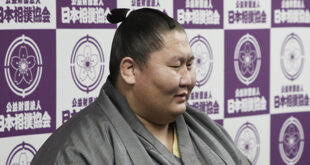
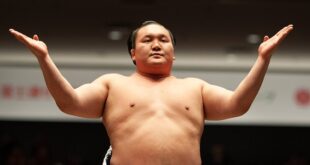
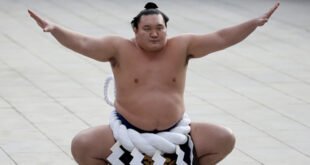
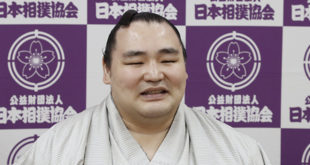
Exact. Santé !
Mystère oui, mais c’est dommage ça le dessert plus qu’autre chose cette fin tardive… Son Heya aurait dû l’arrêter dès le tournoi de Novembre voir même avant. Outre les blessures, la pression d’une nation l’a totalement anéanti depuis un moment, il était pensif en combat, non combatif, comme si il était là à contre cœur. C’est triste. Pensons et buvons un verre à sa santé et sa carrière ! Merci Kisenosato.
Tout a fait d’accord avec cette analyse.
Respect également à Kisenosato.
Quant a une réforme du système d’accession au grade de Yokozuna, plutôt pour. Un Ozeki souvent kadoban peut il devenir un bon Yokozuna ? J’en doute.
Si Kisenosato ne s’était pas blessé aurait il fait mieux ? Mystère !
Respect pour sa longue carrière, même si être Yokozuna aura précipité sa fin.
Trop de blessures (comme beaucoup en même temps) mais sa pose des questions pour le futur à la NSK, faut il revoir les manières d’accéder au graal « Yokozuna »?
Car si on observe Kisenosato, il était un Ozeki respectable qui a connu un pic fulgurant de « réussite » lui permettant le Graal, mais était-il, au regard de sa carrière un probable futur Yokozuna?
Kotoshogiku aurait pu avoir le même destin il y a peu de temps, il était Ozeki, un pic de forme et le Japon attendait son Yokozuna maison. Malheureusement pour lui il n’a pas eu la réussite, mais leur parcours est similaire, un pic puis une inexorable descente.
Kotoshogiku a l’avantage de pouvoir continuer sa carrière car il n’est pas Yokozuna.
Bref, avec le scandale Harumafuji et la débâcle Kisenosato, le Yokozuna n’a pas la côte en ce moment.